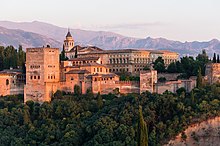Alhambra

The Alhambra is a palace and fortress complex located in Granada, Andalusia, Spain. It was originally constructed as a small fortress in 889 CE on the remains of ancient Roman fortifications, and then largely ignored until its ruins were renovated and rebuilt in the mid-13th century by the Arab Nasrid emir Mohammed ben Al-Ahmar of the Emirate of Granada, who built its current palace and walls. It was converted into a royal palace in 1333 by Yusuf I, Sultan of Granada. After the conclusion of the Christian Reconquista in 1492, the site became the Royal Court of Ferdinand and Isabella (where Christopher Columbus received royal endorsement for his expedition), and the palaces were partially altered in the Renaissance style. In 1526, Charles I of Spain commissioned a new Renaissance palace better befitting the Holy Roman Emperor in the revolutionary Mannerist style influenced by humanist philosophy in direct juxtaposition with the Nasrid Andalusian architecture, but it was ultimately never completed due to Morisco rebellions in Granada.
| This article is a stub. You can help out with Wikiquote by expanding it! |
Quotes
[edit]- There is no pain in life, they say in Granada, so cruel as to be blind in Alhambra. When the Arabs of the desert conquered Spain, they said that they had reached heaven. From the ramparts of the Alhambra, sitting on a spur of the Sierra Nevada, look out and you see a paradise created by nature; look in and you see a paradise created by man.
- Akbar, M. J - The shade of swords_ Jihad and the conflict between Islam and christianity-Routledge (2008)

